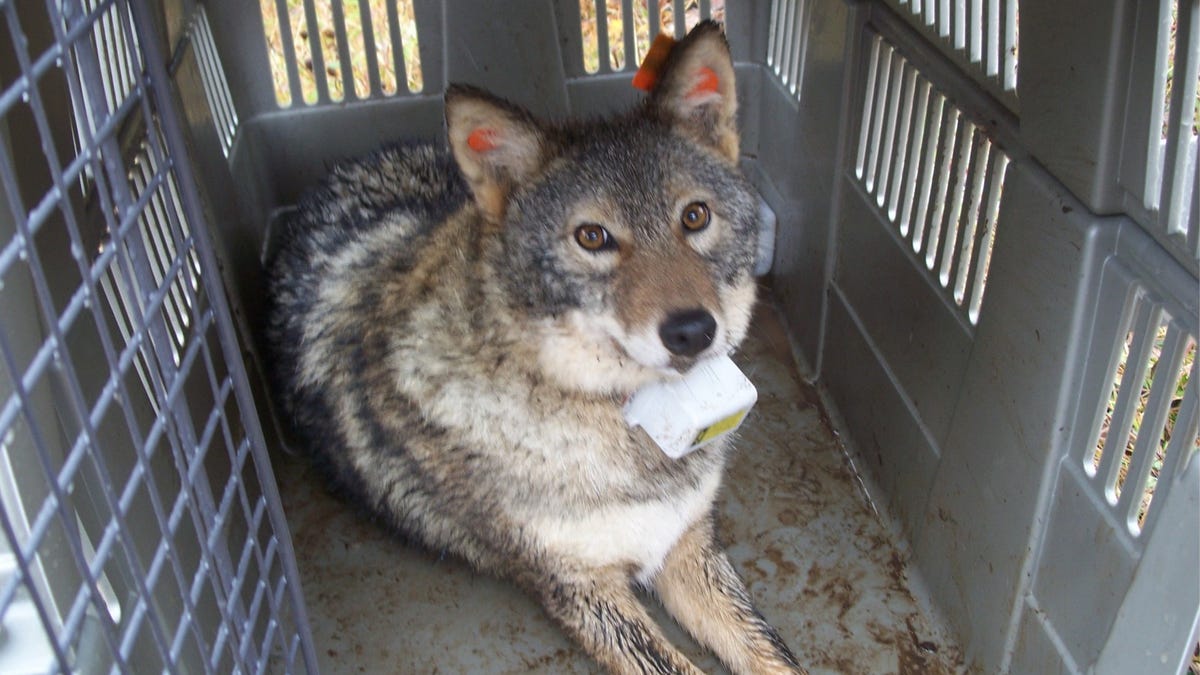Technologies
A Coyote Unexpectedly Killed a Human in 2009. Scientists Now Know Why
It’s likely due to an unexpected dietary adaptation.

In 2009, 19-year-old folk singer Taylor Mitchell was attacked by a pack of coyotes while on a hike at the Cape Breton Highlands National Park in Canada. She was just about to start the popular Skyline Trail when climbers in the area saw the animals close- in, unprovoked.
Onlookers called 911, and Mitchell was airlifted to a hospital in Halifax, but 12 hours later, she died from her injuries.
This marked the very first documentation of a coyote attack in North America that resulted in a human adult fatality (in 1981, 3-year-old Kelly Keene was killed by a coyote on her family’s property), raising questions about whether it’s no longer safe to co-exist with these furry mammals.
«We didn’t have good answers,» Stan Gehrt, a professor in Ohio State’s School of Environment and Natural Resources and leader of the Urban Coyote Research Project, said in a statement.
But after conducting a multi-year investigation into the incident, Gehrt appears to have offered some insight into the situation at last.
According to a paper published last month in the Journal of Applied Ecology, he along with a crew of wildlife researchers found that coyotes in the region of Mitchell’s attack have adopted an unusual dietary change. Rather than rely on smaller mammals like rodents, birds and snakes for food, they seem to be hunting moose for their meals due to extreme climate conditions forcing the former to move away.
As such, the team believes it’s possible these coyotes learned to attack larger mammals, like humans, and are therefore more prone to killing people.
«We’re describing these animals expanding their niche to basically rely on moose. And we’re also taking a step forward and saying it’s not just scavenging that they were doing, but they were actually killing moose when they could. It’s hard for them to do that, but because they had very little if anything else to eat, that was their prey,» Gehrt said. «And that leads to conflicts with people that you wouldn’t normally see.»
Coyote forensics
Before and after the 2009 tragedy, Gehrt’s project noticed a few dozen less-severe human-coyote incidents in the park as well. He and colleagues even fitted them with what are basically GPS trackers so they could document the animals’ movements and better understand why they were behaving in such surprisingly vicious ways.
«We had been telling communities and cities that the relative risk that coyotes pose is pretty low, and even when you do have a conflict where a person is bitten, it’s pretty minor,» he said. «The fatality was tragic and completely off the charts. I was shocked by it — just absolutely shocked.»
To arrive at their conclusions — that coyotes in Cape Breton National Park were feasting on large moose – the team first collected whiskers of both the coyotes implicated in Mitchell’s death and those related to other more minor incidents between 2011 and 2013. They then collected fur from a wide range of potential coyote prey such as shrews, southern red-backed voles, snowshoe hare, moose and even humans — for humans, they gathered hair from local barber shops.
Seth Newsome, a professor of biology at the University of New Mexico and corresponding author of the study, performed an analysis of specific carbon and nitrogen isotopes within all the samples.
Eventually, Newsome confirmed that, on average, moose constituted between half and two-thirds of the animals’ diets, followed by snowshoe hare, small mammals and deer, according to the press release. Plus, the researchers analyzed coyote droppings, which confirmed the isotope findings further.
Interestingly, they also only found a few examples of individuals having eaten human food, debunking any claims that coyotes’ attraction to human food might’ve been a factor in Mitchell’s attack.
«These coyotes are doing what coyotes do, which is, when their first or second choice of prey isn’t available, they’re going to explore and experiment and change their search range,» Gehrt said. «They’re adaptable, and that is the key to their success.»
From those movement devices, the team tested to see whether coyotes in the park were just familiar with people. However, patterns showed that the animals largely avoided areas of the park frequented by people. Instead, they preferred walking around at night.
«The lines of evidence suggest that this was a resource-poor area with really extreme environments that forced these very adaptable animals to expand their behavior,» Gehrt said. Or as the paper puts it, «our results suggest extreme unprovoked predatory attacks by coyotes on people are likely to be quite rare and associated with unique ecological characteristics.»
Technologies
Today’s NYT Connections: Sports Edition Hints and Answers for Nov. 29, #432
Here are hints and the answers for the NYT Connections: Sports Edition puzzle for Nov. 29, No. 432.

Looking for the most recent regular Connections answers? Click here for today’s Connections hints, as well as our daily answers and hints for The New York Times Mini Crossword, Wordle and Strands puzzles.
It’s Rivalry Saturday, so Connections: Sports Edition gives a big game a nod with two caregories. If you’re struggling with today’s puzzle but still want to solve it, read on for hints and the answers.
Connections: Sports Edition is published by The Athletic, the subscription-based sports journalism site owned by The Times. It doesn’t appear in the NYT Games app, but it does in The Athletic’s own app. Or you can play it for free online.
Read more: NYT Connections: Sports Edition Puzzle Comes Out of Beta
Hints for today’s Connections: Sports Edition groups
Here are four hints for the groupings in today’s Connections: Sports Edition puzzle, ranked from the easiest yellow group to the tough (and sometimes bizarre) purple group.
Yellow group hint: Fire it on in there.
Green group hint: Buckeyes.
Blue group hint: Wolverines.
Purple group hint: Not double.
Answers for today’s Connections: Sports Edition groups
Yellow group: Baseball pitching feats.
Green group: Associated with Ohio State.
Blue group: Associated with Michigan.
Purple group: Triple ____.
Read more: Wordle Cheat Sheet: Here Are the Most Popular Letters Used in English Words
What are today’s Connections: Sports Edition answers?
The yellow words in today’s Connections
The theme is baseball pitching feats. The four answers are immaculate inning, no-hitter, perfect game and shutout.
The green words in today’s Connections
The theme is associated with Ohio State. The four answers are dotting the I, gray, scarlet and The Horseshoe.
The blue words in today’s Connections
The theme is associated with Michigan. The four answers are blue, Hail to the Victors, maize and The Big House.
The purple words in today’s Connections
The theme is triple ____. The four answers are A, crown, double and play.
Technologies
Today’s NYT Mini Crossword Answers for Saturday, Nov. 29
Here are the answers for The New York Times Mini Crossword for Nov. 29.

Looking for the most recent Mini Crossword answer? Click here for today’s Mini Crossword hints, as well as our daily answers and hints for The New York Times Wordle, Strands, Connections and Connections: Sports Edition puzzles.
Need some help with today’s Mini Crossword? It’s Saturday, so it’s a long one. Read on for all the answers. And if you could use some hints and guidance for daily solving, check out our Mini Crossword tips.
If you’re looking for today’s Wordle, Connections, Connections: Sports Edition and Strands answers, you can visit CNET’s NYT puzzle hints page.
Read more: Tips and Tricks for Solving The New York Times Mini Crossword
Let’s get to those Mini Crossword clues and answers.
Mini across clues and answers
1A clue: Hockey disks
Answer: PUCKS
6A clue: Signature headwear for Mr. Monopoly
Answer: TOPHAT
7A clue: Seedy establishment?
Answer: NURSERY
8A clue: Bioweapon at the center of a 2001 envelope scare
Answer: ANTHRAX
9A clue: Cleverly skillful
Answer: ADROIT
10A clue: Sleeping enclosure for a pet dog
Answer: CRATE
11A clue: Picks up the tab
Answer: PAYS
Mini down clues and answers
1D clue: Play, as a film character
Answer: PORTRAY
2D clue: Ultimate consequences
Answer: UPSHOTS
3D clue: Sweetheart, in French
Answer: CHERIE
4D clue: 24-___ gold
Answer: KARAT
5D clue: River in which Achilles was dipped (except for his heel!)
Answer: STYX
6D clue: Frozen landscape
Answer: TUNDRA
7D clue: Civil rights org. co-founded by W.E.B. Du Bois
Answer: NAACP
Don’t miss any of our unbiased tech content and lab-based reviews. Add CNET as a preferred Google source.
Technologies
Repair Your Electronics at Home With This Rare Black Friday Discount on the iFixit Pro Tech Go Toolkit
This toolkit rarely goes on sale, so take advantage of this opportunity to snag it for only $40.

While Black Friday is an excellent time to replace old smartphones or broken laptops at a discount, not everyone is looking to splurge on new tech right now. If you’re shopping on a budget, or simply like the devices that you have and aren’t ready for an upgrade, investing in an electronics repair kit may be a wise option. We’ve spotted a discount on the iFixit Pro Tech Go tech toolkit, bringing its price down to just $40. But don’t delay, Black Friday is in its final hours and this kit rarely goes on sale.
The iFixit Pro Tech Go kit can be used to open up and repair a wide range of electronics, including smartphones, laptops, gaming consoles, and smart home devices for DIY repairs like battery or screen replacements. The kit has a 32-bit Moray driver kit, an opening tool, a suction handle, a jimmy, a spudger and angled tweezer to carefully open your devices.
Don’t miss any of our unbiased tech content and lab-based reviews. Add CNET as a preferred Google source.
Repairing your own tech can save you hundreds or even thousands of dollars. It also reduces e-waste by helping your devices last longer rather than throwing them away over minor issue. As of this year, all 50 states have introduced right-to-repair legislation designed to give people a legal right to fix their own tech, and several states have already signed it into law.
You can check out more deals from iFixIt now on Amazon. Plus, for other budget buys, check out our roundup of the best Black Friday deals under $100.
MOBILE DEALS OF THE WEEK
-
$749 (save $250)
-
$475 (save $175)
-
$499 (save $300)
-
$900 (save $400)
Why this deal matters
This is a record low price on a repair kit that rarely goes on sale. While we did see a modest discount on the iFixit Pro Tech Go toolkit during Amazon Prime Day in July, it was not marked down for October Prime Day or other sales such as Memorial Day or Labor Day. As such, it’s fairly unlikely that we’ll see it go on sale again this season, so this might be your last chance to get the toolkit for only $40.
Join Our Daily Deals Text Group!
Get hand-picked deals from CNET shopping experts straight to your phone.
By signing up, you confirm you are 16+ and agree to receive recurring marketing messages at the phone number provided. Consent is not a condition of purchase. Reply STOP to unsubscribe. Msg & data rates may apply. View our Privacy Policy and Terms of Use.
-

 Technologies3 года ago
Technologies3 года agoTech Companies Need to Be Held Accountable for Security, Experts Say
-

 Technologies3 года ago
Technologies3 года agoBest Handheld Game Console in 2023
-

 Technologies3 года ago
Technologies3 года agoTighten Up Your VR Game With the Best Head Straps for Quest 2
-

 Technologies4 года ago
Technologies4 года agoBlack Friday 2021: The best deals on TVs, headphones, kitchenware, and more
-

 Technologies4 года ago
Technologies4 года agoVerum, Wickr and Threema: next generation secured messengers
-

 Technologies4 года ago
Technologies4 года agoGoogle to require vaccinations as Silicon Valley rethinks return-to-office policies
-

 Technologies4 года ago
Technologies4 года agoOlivia Harlan Dekker for Verum Messenger
-

 Technologies4 года ago
Technologies4 года agoiPhone 13 event: How to watch Apple’s big announcement tomorrow
